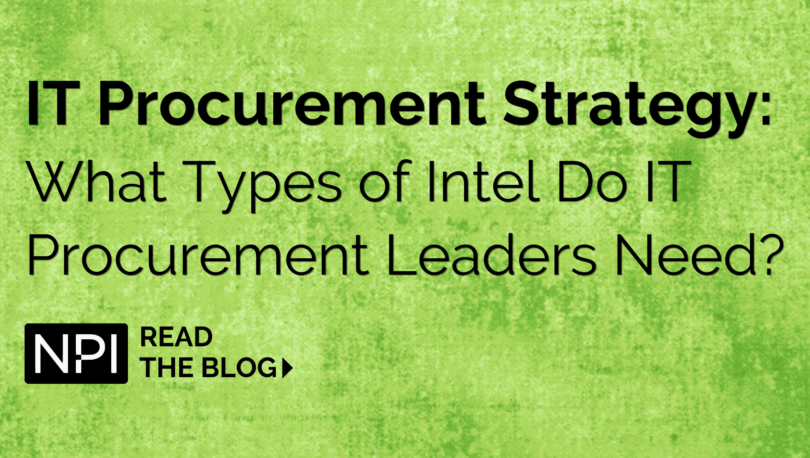IT procurement leaders have always had a data issue. For years, the challenge was a lack of visibility into vendor pricing, licensing and use rights – and that’s still a major issue today. However, one could argue that leaders who are committed to strong enterprise IT procurement strategy are now drowning in data. There are analyst reports, supplier scorecards, product SKUs, bundling options, complex use rights, contractual T&Cs, vendor-generated dashboards, ESG ratings, financial risk assessments, infosec requirements, and that’s just the beginning of it.
This points to an overarching challenge: data vs. intelligence. IT procurement data, in terms of quantity, is abundant. Intelligence, however, is a different matter.
[IT PROCUREMENT STRATEGY MUST-READ: Go deeper into this topic with our bulletin on Four Types of IT Sourcing Intel to Strengthen the Outcome of Negotiation with Vendors]When it comes to harnessing intelligence, IT procurement and the procuretech landscape are still fairly nascent. Yes, great strides are being made and the marketplace for procuretech is exploding. But it’s still difficult for many practitioners to understand what kind of information will move the needle on cost, risk and responsiveness during the IT buying process.
The requirements for what it takes to negotiate a world-class outcome with IT vendors are changing. Relying on internal experience with each vendor isn’t enough. The rate of change happening both within a company’s IT environment and across the IT marketplace has uncovered the need for intelligence that demonstrably supports the IT purchasing and renewal process.
Below is an explanation of the four types of intel IT buyers need to secure a world-class negotiation outcome:
Historical Pricing and Consumption Intel
Internally sourced, this intel is a record of for the products and services you have purchased form a vendor over time, and a current-state analysis of whether those products/services are currently being used within the business. This information can help you leverage your aggregate footprint with a particular IT supplier. It’s also key in helping identify shelfware that needs to be eliminated or unused assets available for redeployment.
While this info steers purchasers away from overbuying (a cost benefit that shouldn’t be underestimated), it has little bearing on determining if vendor pricing is fair. In fact, as vendors become entrenched in an account, the price tends to go up over time because of lock-in.
Benchmark Pricing Intel
Price disparity is rampant in enterprise IT procurement. What one company pays a vendor for comparable purchase can be anywhere from 20 to 50 percent more than the next company. IT price benchmarking is the only way to determine if you’re paying a fair price for an IT purchase or renewal.
It’s used to analyze whether vendor pricing is in line with fair market value in two ways. The first is by comparing the vendor’s price to the pricing offered by that vendor to other customers. The second is by comparing the vendor’s price to pricing offered by other vendors.
Unfortunately, a lot of companies only focus on competitive price benchmarking – typically during the RFX process. For the most part, competitor pricing information is readily available. But companies rarely have access to what their peers are paying for a similar purchase from the vendor of choice. This intel is not typically found within your organization’s internal sourcing and IT knowledge base. It’s usually acquired through third-party IT pricing experts.
Licensing and Subscription Intel
Paying too much for IT is an obvious path to overspending. Less obvious, but equally important, is buying more quantity than you need or buying overpowered SKUs. Vendor sales teams are skilled at maximizing your purchase. To counterbalance and avoid overspending and overbuying, IT procurement leaders must understand the licensing and subscription offerings that a vendor offers and the various permutations available to them, then select the best-fit basket of goods that optimizes cost, flexibility and risk..
Like benchmark pricing intel, vendor-specific licensing and subscription intel is not typically found within the customer’s organization. With enterprise IT vendors often offering hundreds (even thousands!) of SKUs, it’s become impossible for IT and IT procurement practitioners to stay up to date on key vendor offerings. In most cases, this intel is sourced externally from vendor-specific licensing advisors that have extensive knowledge of various licensing and subscription options and how to best map them to the buyer’s requirements.
Vendor Behavior Intel
The fourth type of IT buying intelligence is focused on how a vendor behaves during the negotiation process. Most IT procurement organizations don’t have visibility into vendor behavior beyond their own interactions. Considering you may only buy or renew with a vendor once every three years, those interactions can be pretty limited. To truly understand what drives vendor behavior – and how to leverage that intel – you need access to real-time insight gleaned from negotiation experience across hundreds of IT purchases.
These insights include things like: What’s motivating the salesperson at the negotiation table?
Where does this particular vendor exhibit flexibility with other customers? What is the best way to communicate with the vendor to achieve the best outcome?
Remember – IT procurement strategy is a chess game and anticipating how the vendor will play will materially improve the outcome!
NPI gives enterprise IT buyers the intel they need to optimize every purchase and renewal. Contact us to learn more.
RELATED CONTENT
- Blog: Advice From the Experts: Enterprise Software Cost and License Optimization Must-Do’s
- Bulletin: Four Types of IT Sourcing Intel to Strengthen the Outcome of Negotiation with Vendors
- Bulletin: 10 Reasons Why IT Buyers Should Perform Price Benchmark Analysis
- NPI Service: IT Price Benchmark Analysis & Contract Negotiation Intel
- NPI Service: Enterprise Software License Optimization Consulting
